- Let’s crack the GATE July 16, 2021
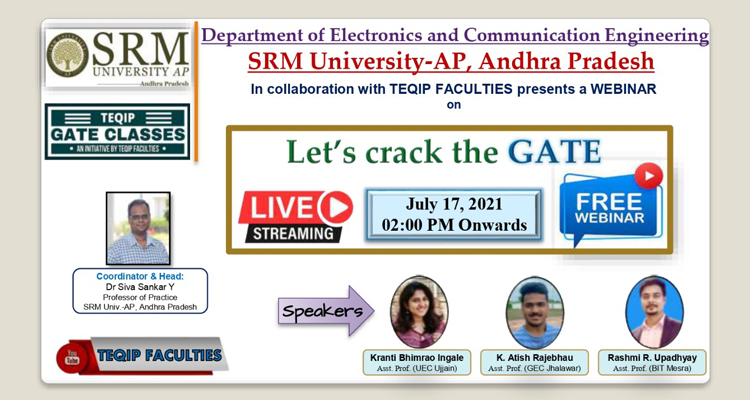 The Department of Electrical and Communications Engineering in collaboration with TEQUIP FACULTIES presents a workshop for GATE aspirants, titled “Let’s crack the GATE” on July 17, 2021, Saturday, at 2.00 pm. Experienced guest speakers namely, Kranti Ingle, Assistant Professor in UEC Ujjain; Atish Katkar, Assistant Professor in GEC Jhalawar; and Rashmi Rathi Upadhyay, Assistant Professor in BIT Mesra will be the trainers of the session. Dr Siva Sankar Y, Professor of Practice from the Department of ECE at SRM University-AP will coordinate the session.
The Department of Electrical and Communications Engineering in collaboration with TEQUIP FACULTIES presents a workshop for GATE aspirants, titled “Let’s crack the GATE” on July 17, 2021, Saturday, at 2.00 pm. Experienced guest speakers namely, Kranti Ingle, Assistant Professor in UEC Ujjain; Atish Katkar, Assistant Professor in GEC Jhalawar; and Rashmi Rathi Upadhyay, Assistant Professor in BIT Mesra will be the trainers of the session. Dr Siva Sankar Y, Professor of Practice from the Department of ECE at SRM University-AP will coordinate the session.Graduate Aptitude Test in Engineering (GATE) is the gateway for admission into the Masters Program and Job in Public Sector Companies. It is a national level examination that tests the comprehensive understanding of various undergraduate subjects in engineering and science. GATE is conducted jointly by the Indian Institute of Science (IISc) Bangalore and seven Indian Institutes of Technology (IITs) at Bombay, Delhi, Guwahati, Kanpur, Kharagpur, Madras and Roorkee on behalf of the National Coordination Board (NCB)-GATE, Department of Higher Education, Ministry of Education (MoE), Government of India.
All prudent BTech students preparing for GATE are invited to attend this workshop on July 17, 2021, at 2.00 pm to know more about this Computer Based Test (CBT) that has a crucial role in the life of an engineering graduate.
Continue reading → - New materials for energy and information storage and transmission July 15, 2021
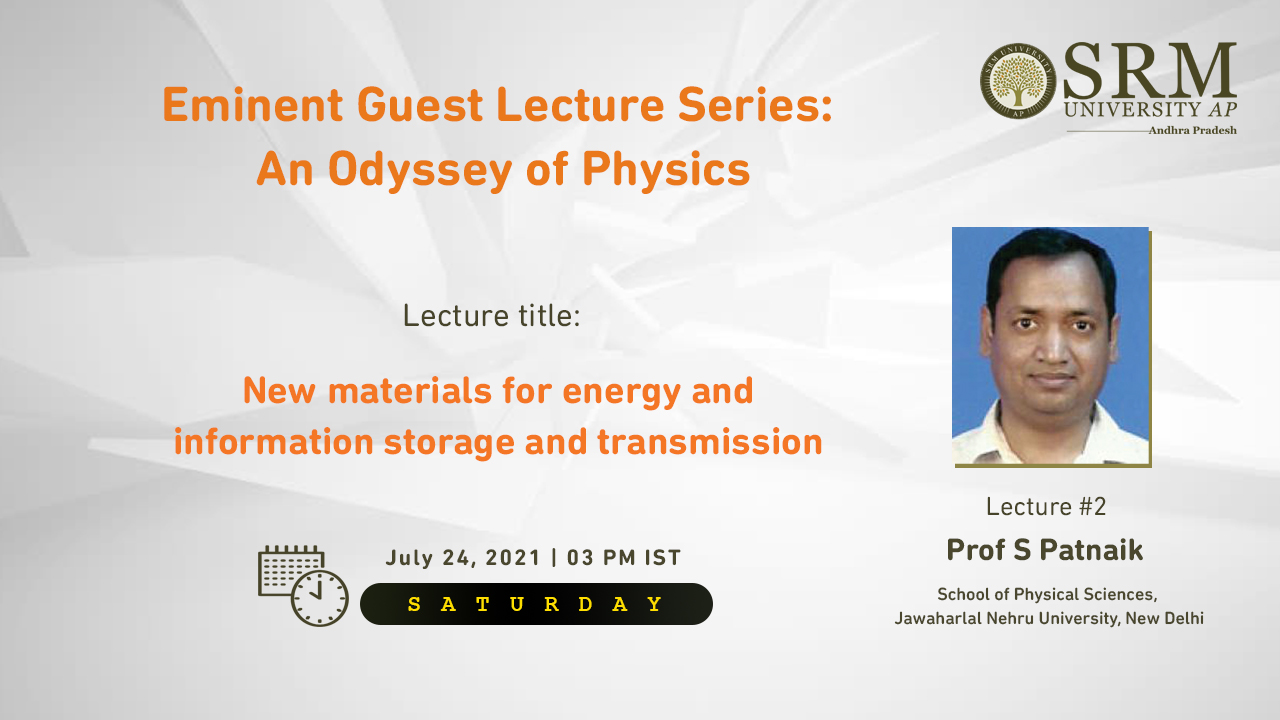 The Department of Physics at SRM University-AP is organising the second edition of the Eminent Guest Lecture Series: An Odyssey of Physics on July 24, 2021, Saturday at 3.00 pm. The session will be engaged by Prof S Patnaik from the School of Physical Sciences in Jawaharlal Nehru University, New Delhi on the subject “New Materials for Energy and Information Storage and Transmission”. Prof. V S Rao, Vice-Chancellor; Prof. D. Narayana Rao, Pro-Vice-Chancellor; Prof. C Durga Rao, Associate Dean, SLASS; Prof. Ranjit Thapa; Prof. Amit Chakraborty; and Prof. Pranab Mandal from the Department of Physics at SRM University-AP will be the panellists for the session.
The Department of Physics at SRM University-AP is organising the second edition of the Eminent Guest Lecture Series: An Odyssey of Physics on July 24, 2021, Saturday at 3.00 pm. The session will be engaged by Prof S Patnaik from the School of Physical Sciences in Jawaharlal Nehru University, New Delhi on the subject “New Materials for Energy and Information Storage and Transmission”. Prof. V S Rao, Vice-Chancellor; Prof. D. Narayana Rao, Pro-Vice-Chancellor; Prof. C Durga Rao, Associate Dean, SLASS; Prof. Ranjit Thapa; Prof. Amit Chakraborty; and Prof. Pranab Mandal from the Department of Physics at SRM University-AP will be the panellists for the session.Abstract:
The discovery of Dirac and Weyl semimetals (WSM) has brought forth the condensed-matter realization of Dirac/Weyl fermions, which were previously theorised as low energy excitations in high energy particle physics. In the recent past, we have witnessed some exceptional developments in chalcogenide and pnictide materials that have been identified with such properties. Several age-old industrial materials based on selenides, tellurides, borides and oxides have come to the fore that promise to usher in a new understanding of correlated electronic systems. Towards material implementation of quantum computation, we shall review the electromagnetic properties of topological superconductor SrxBi2Se3 and study its pairing mechanism. Several transition metal mono-pnictides are under intense investigation for understanding the properties of inversion-symmetry broken Weyl semimetals. Non-trivial Berry phase and chirality are important markers for characterizing topological aspects of Weyl semimetals. We shall discuss aspects of exceptional magneto-resistance seen in the normal state of these topological semimetals. In specific, we shall summarize potential applications with regard to material properties of the following systems a) Single-stage cryocooled superconducting magnets for MRI (MgB2), b) Cables for lossless energy transmission and storage (Bi2Sr2Ca2Cu3O10), c) Materials to implement Quantum Computation (Sr intercalated Bi2Se3), d) Better read-heads for magnetic storage devices (NbP, TaSb2), e) Magnetic Nano-particles for Cancer therapy (Co+CoO EB), f) Thermoelectric materials for waste heat scavenging (ZrNiPb), g) Next-generation piezo devices using multiferroic materials. (Y2CoMnO6) and h) new ideas on solar energy and battery applications.About the Speaker:
Dr S Patnaik is a distinguished professor at the School of Physical Sciences at Jawaharlal Nehru University (JNU), New Delhi. He has more than 16 years of experience in the field of research and academics. Dr Patnaik has over 5000 citations for published works. He has international collaborations with the University of Wisconsin-Madison, USA, Université Paris Sud, Orsay, France, University of Cambridge, Cambridge, UK and Institute of Physics, Chinese Academy of Sciences, Beijing. Dr Patnaik’s areas of interest or specialisation are Experimental Condensed Matter Physics, Superconductivity, Mutiferroics and Thermoelectric materials.Join this educative lecture session on July 24, 2021, at 3.00 pm.
Register here:https://srmap.zoom.us/webinar/register/WN_zEhuvRipRNSafZtxv3Jstg
Continue reading → - Insights into signal processing @ ECE Department July 15, 2021
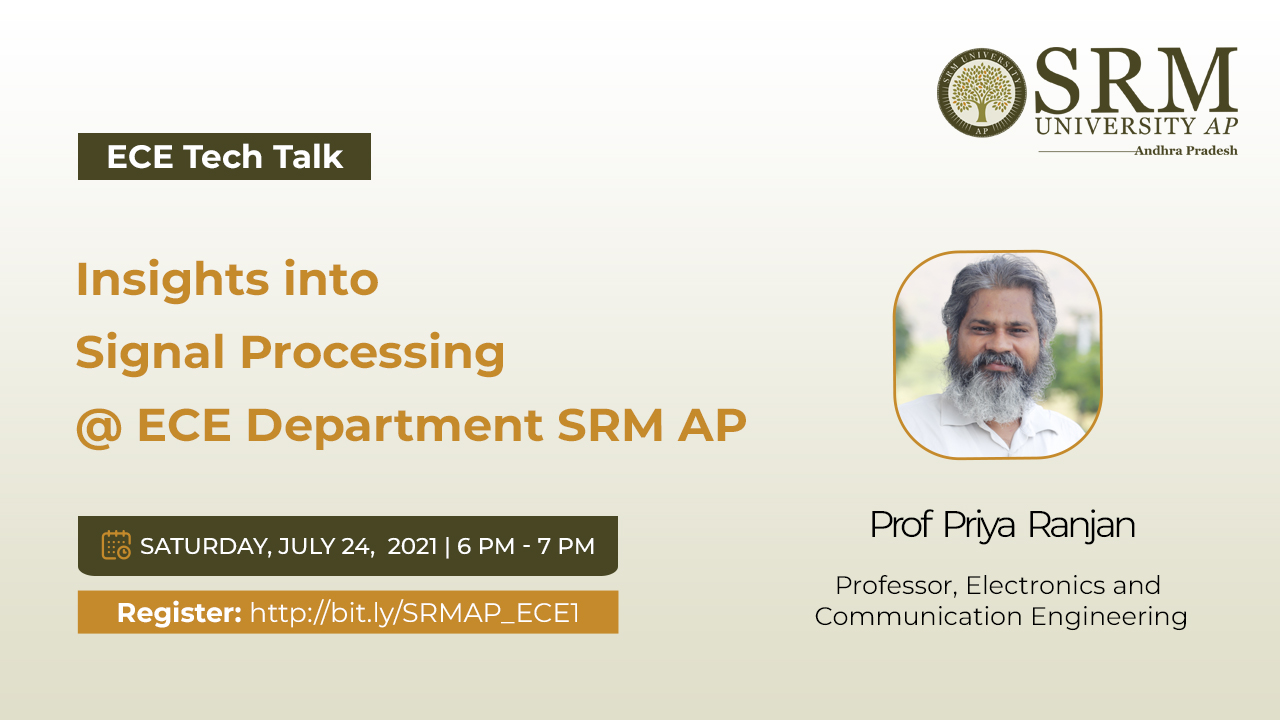 The Department of Electrical and Communication Engineering at SRM University-AP is organising a webinar session on the topic “Insights into Signal Processing @ ECE Department SRM AP” on July 24, 2021, Saturday, at 6.00 pm. Prof Priya Ranjan from the department will elucidate on the topic via the zoom platform.
The Department of Electrical and Communication Engineering at SRM University-AP is organising a webinar session on the topic “Insights into Signal Processing @ ECE Department SRM AP” on July 24, 2021, Saturday, at 6.00 pm. Prof Priya Ranjan from the department will elucidate on the topic via the zoom platform.Signal processing is a widely used technology that pervades every aspect of our lives. Signal describes how some physical quantity varies over time or space for example sound pressure, radio/television broadcast, movies, electrocardiogram etc. Signal processing is a subfield of electrical engineering that involves manipulating a signal to change the basic characteristics of a signal or to extract some information from it. This is performed by computers, special purpose integrated circuits or Analog electrical circuits.
To know more about analysing, modifying, and synthesising signals with the Department of ECE, join this invigorative webinar on July 24, 2021, from 6.00 pm onwards.
Register here: //srmap.zoom.us/webinar/register/WN_8KLpAUpgRZiWnL9U6AimjQ
Continue reading → - Dr Nimai Mishra’s research group develops a new synthetic strategy to make ultra-stable CsPbBr3 perovskite nanocrystals for light-emitting application July 14, 2021
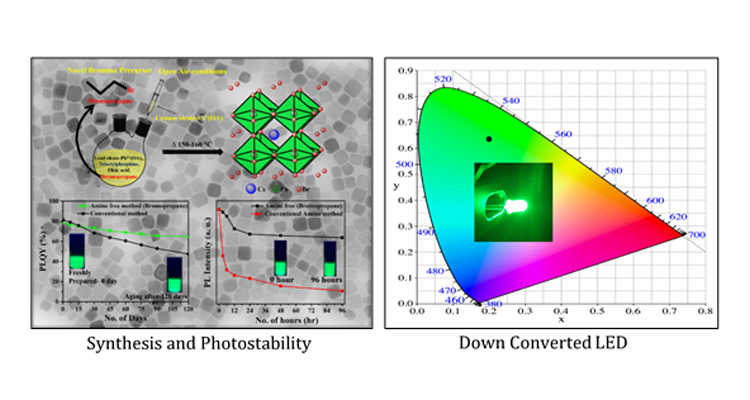 Dr Nimai Mishra, Assistant Professor in the Department of Chemistry, SRM University-AP, Andhra Pradesh, along with his research group comprising of students pursuing PhD under his supervision, Mr Syed Akhil and Ms V.G.Vasavi Dutt have published a research article titled “Bromopropane as a Novel Bromine Precursor for the Completely Amine Free Colloidal Synthesis of Ultra-Stable and Highly Luminescent Green-Emitting Cesium Lead Bromide (CsPbBr3) Perovskite Nanocrystals” in the Journal “Nanoscale” (The Royal Society of Chemistry, Impact Factor-7.8).
Dr Nimai Mishra, Assistant Professor in the Department of Chemistry, SRM University-AP, Andhra Pradesh, along with his research group comprising of students pursuing PhD under his supervision, Mr Syed Akhil and Ms V.G.Vasavi Dutt have published a research article titled “Bromopropane as a Novel Bromine Precursor for the Completely Amine Free Colloidal Synthesis of Ultra-Stable and Highly Luminescent Green-Emitting Cesium Lead Bromide (CsPbBr3) Perovskite Nanocrystals” in the Journal “Nanoscale” (The Royal Society of Chemistry, Impact Factor-7.8).Recently, lead halide perovskite nanocrystals (PNCs) have attracted intense interest as promising active materials for optoelectronic devices. However, their extensive applications are still hampered by poor stability in ambient conditions. In this work, Dr Mishra’s research group report an open-atmospheric, facile, efficient, completely amine-free synthesis of caesium lead bromide perovskite nanocrystals using a novel bromine precursor, bromopropane, which is inexpensive, and available at hand. Their finding concludes that the PLQY can maintain 83% of their initial one even after 120 days. Furthermore, after 96 h of continuous irradiation by UV light with 365 nm (8 W/cm2) in the open ambient condition the photoluminescence (PL) intensity showed retention of 68% of its original value with no significant change in full width at half-maximum, whereas amine-based sample retains only 5% of its original PL intensity. Furthermore, Dr Mishra’s group has fabricated stable down-converted LED devices with these perovskite nanocrystals.
“More importantly, the present work demonstrates the synthesis of ultra-stable CsPbBr3 NCs which can be an ideal candidate for display applications”, says Dr Nimai Mishra.
Read the full paper: https://pubs.rsc.org/en/Content/ArticleLanding/2021/NR/D1NR03560F#!divAbstract
Continue reading →
- Design of modern MW size wind turbine rotor blades July 14, 2021
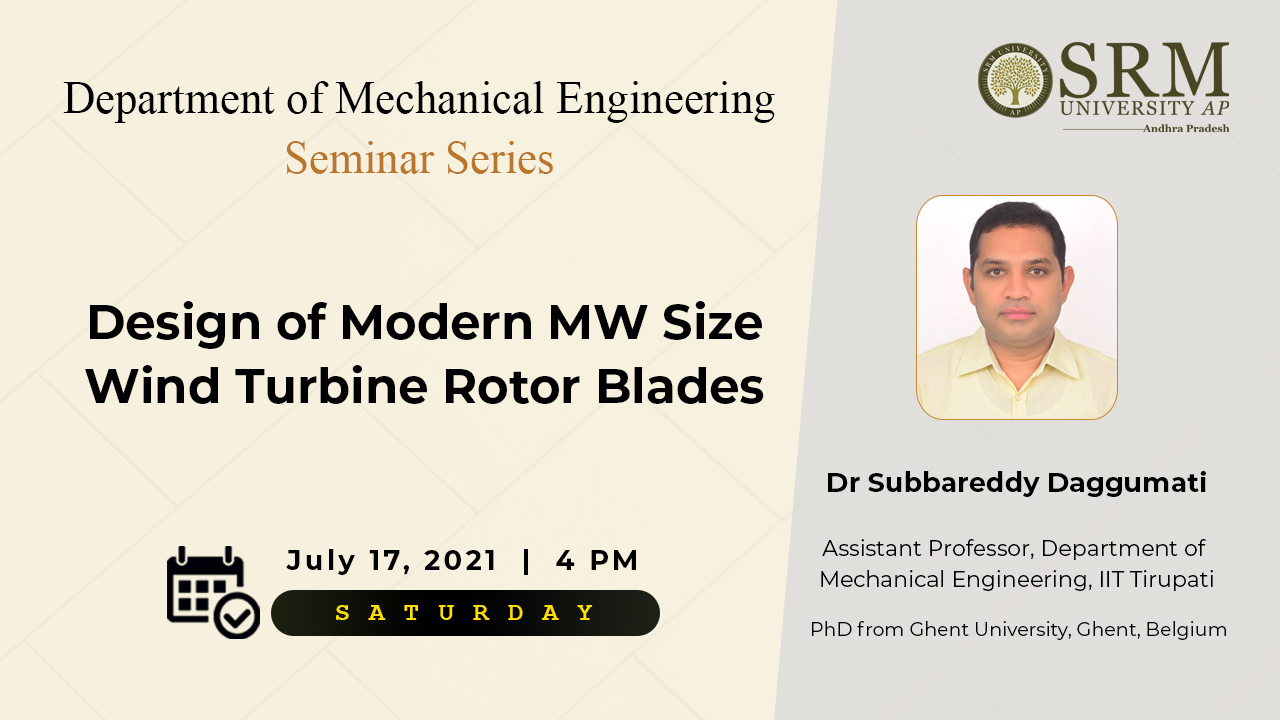 Department of Mechanical Engineering at SRM University-AP organises a talk on “Design of Modern MW Size Wind Turbine Rotor Blades” as part of the departmental seminar series on July 17, 2021, at 4.00 pm. Dr Subbareddy Daggumati, Assistant Professor at IIT Tirupati will be the guest speaker at the event. This talk aims to highlight the various energy sources in India and the role of renewable energy in electricity production.
Department of Mechanical Engineering at SRM University-AP organises a talk on “Design of Modern MW Size Wind Turbine Rotor Blades” as part of the departmental seminar series on July 17, 2021, at 4.00 pm. Dr Subbareddy Daggumati, Assistant Professor at IIT Tirupati will be the guest speaker at the event. This talk aims to highlight the various energy sources in India and the role of renewable energy in electricity production.Dr Daggumati obtained his PhD from Ghent University, Belgium. He had been the wind turbine blade designer at Siemens and General Electric Co. In this lecture, he will elucidate on the energy production using wind energy. The kinetic energy of wind is collected using the blades of wind turbines. Wind flows over the blades creating lift (similar to the effect on aeroplane wings), which causes the blades to turn. The blades are connected to a drive shaft that turns an electric generator, which produces (generates) electricity. The lecture will consequently introduce various parts of modern MW size wind turbine parts to the attendees. The methods to develop wind turbine rotor blade designs will also be discussed in detail.
Join this technical lecture organised by the Department of Mechanical Engineering on July 17 at 4.00 pm to learn more about the design of modern MW size wind turbine rotor blades.
Zoom Link: https://srmap.zoom.us/j/96497015237?pwd=OVdiNlhaQy8raFRnYS9RWUtyR0VOUT09#success
Continue reading →

